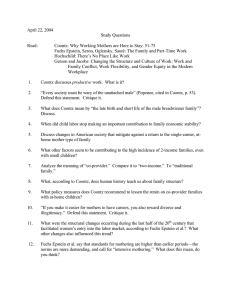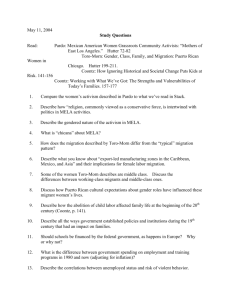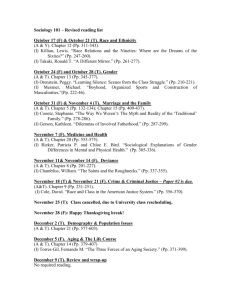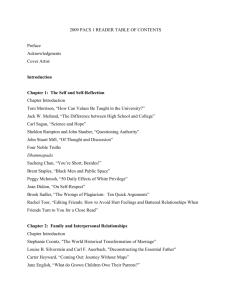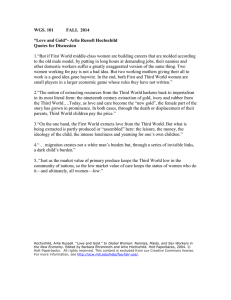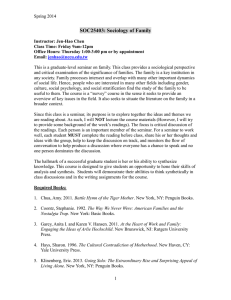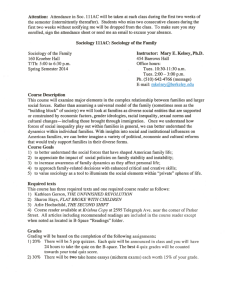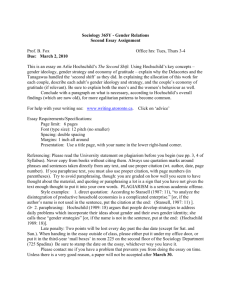April 22, 2004 Read:
advertisement
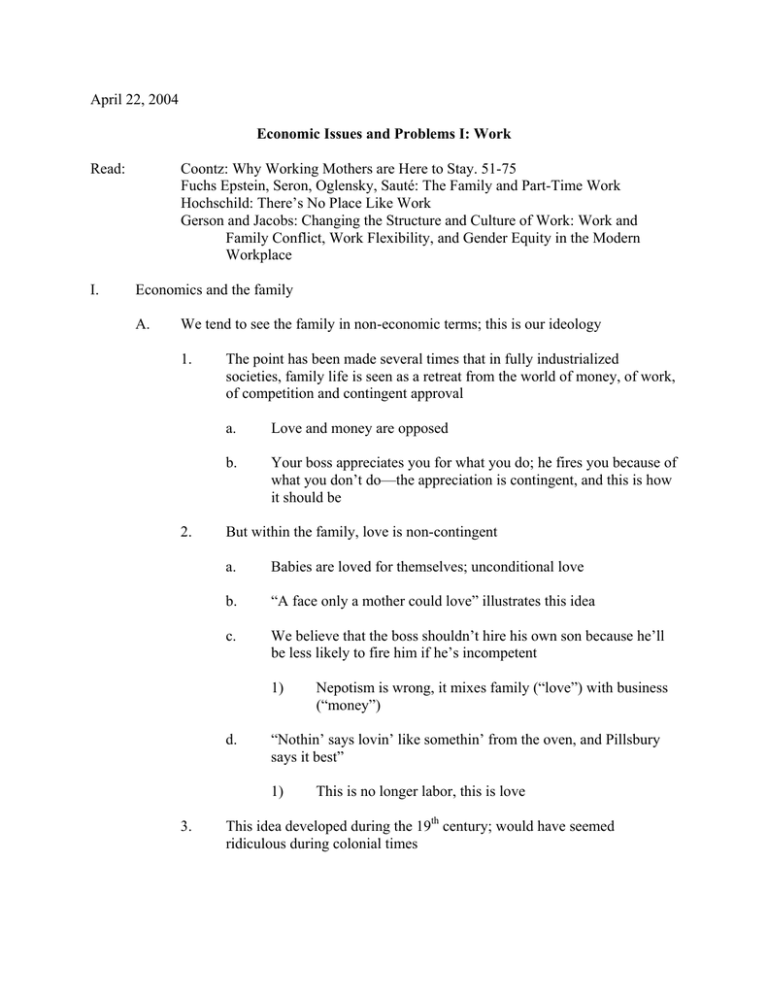
April 22, 2004 Economic Issues and Problems I: Work Read: I. Coontz: Why Working Mothers are Here to Stay. 51-75 Fuchs Epstein, Seron, Oglensky, Sauté: The Family and Part-Time Work Hochschild: There’s No Place Like Work Gerson and Jacobs: Changing the Structure and Culture of Work: Work and Family Conflict, Work Flexibility, and Gender Equity in the Modern Workplace Economics and the family A. We tend to see the family in non-economic terms; this is our ideology 1. 2. The point has been made several times that in fully industrialized societies, family life is seen as a retreat from the world of money, of work, of competition and contingent approval a. Love and money are opposed b. Your boss appreciates you for what you do; he fires you because of what you don’t do—the appreciation is contingent, and this is how it should be But within the family, love is non-contingent a. Babies are loved for themselves; unconditional love b. “A face only a mother could love” illustrates this idea c. We believe that the boss shouldn’t hire his own son because he’ll be less likely to fire him if he’s incompetent 1) d. “Nothin’ says lovin’ like somethin’ from the oven, and Pillsbury says it best” 1) 3. Nepotism is wrong, it mixes family (“love”) with business (“money”) This is no longer labor, this is love This idea developed during the 19th century; would have seemed ridiculous during colonial times 2 II. a. As Coontz points out, women were co-providers throughout history, certainly during colonial period b. During 19th century men became the “providers” c. The idea of women “giving” through their labor, while still present, was submerged into the notion of “doing for” one’s family But work and family remain connected in any number of ways A. Notion that one works, and the family is the reward, one works because of one’s family 1. Adults and, in many places in the world, children and young adults as well B. Discuss: other connections between “family” and “work”? C. How should we define “work” 1. Something you wouldn’t do unless someone paid you for it 2. This definition doesn’t apply to: a. The “work” you do at MIT—you’re not paid, rather, you pay me 1) b. 3. Clearly I’m the one doing the work here The work you do at home that you’d really rather not do, yet you’re not paid for it As I said last time about the word “violence,” the definition of “work” depends on who’s defining it a. Is taking care of children “work”? 1) Very few members of traditional societies would say it was 2) Members of colonial families would disagree 3) So would women fitting the “cult of true womanhood” model of the 19th century a) Sacred duty (duty is and isn’t “work”) b) What they do as part of their identity, their role, but not quite work yet 3 b. c. While nurses, governesses, etc., were hired to “take care” of middle- and upper-class children earlier, 1) It is only with post-industrial capitalism that we understand taking care of children to constitute work like any other work 2) Because we pay people to do that particular task Clearly, whether you see taking care of children, yours or someone else’s, as work 1) d. D. Depends on how you define work If your definition requires a degree of unwillingness, then childcare might very well be “fun,” or even “pay” for something else rather than work What is “productive” work? 1. Work that produces a product a. Taking care of children is productive work only in an extended sense b. We basically see it as a service 2. As Coontz notes, colonial mothers engaged in productive work just as much as colonial fathers 3. And, earlier fathers did a lot of parenting that we now see as “naturally” belonging to the mother 4. It is quite clear that “productive” work no longer occurs within the household 5. The work that goes on there is: a. Service (a notion fully embedded within the cash nexus) b. And what Hochschild calls “emotion work” 1) The idea of “emotion work” requires an additional definition 4 2) E. Behavior that’s necessary to do if a goal is to be met Coontz’s use of “co-provider” 1. If it means more than work for pay (and it does), it is vague—on purpose 2. Avoids some of the misunderstandings of “work” a. We know immediately what Coontz means when she says “why working mothers are here to stay” 1) b. Otherwise we wouldn’t laugh at a T shirt that says “every mother is a working mother” But implicated in this phrase is the idea that unremunerated work isn’t “real work” 1) Which is certainly true a) 3. Several readings discuss the co-variance between power, ability to leverage and bringing in a paycheck in many marriages “Co-provider” is gender neutral a. “Househusband” is not on anyone’s list of possible career choices, although “housewife” used to be b. But because “I’m just a housewife” suggested a low-prestige job, and suggested they were married to the house c. “Homemaker” was substituted on the census form: home” bettersounding 1) d. And “maker” suggested productive work I recently sat next to a woman with a 7-month-old baby on her lap on the plane 1) We spoke about her choice to be a full-time mother a) 2) Note: next to her was the child’s nanny from the Islands, across the aisle was her husband I spoke about the implications of the fact that stay-at-home mothers 5 e. 4. When asked what their occupation is b) Respond by describing what they used to do, even though they’re not doing it anymore c) She’d practiced law; but she said she describes herself as “CEO” of her home d) A joke (and a code indicating social class) A couple of years ago a friend of mine severed a tendon in his hand washing dishes 1) His wife told me that when she described to their older Italian neighbor what had happened 2) He said “served him right for doing women’s work” And site neutral a. F. a) Doesn’t signal home or the workplace the way “does your mother work?” does Hochschild’s play on words 1. Saying that “work” had become “home” to some mothers, and “home” had become work a. A reversal of the idealized “home” of the 19th century: b. Remember this poem? Two birds within one nest Two hearts within one breast Two souls within one fair Firm league of love and prayer Together bound for aye, together blest An ear that waits to catch A hand upon the latch A step that hastens its sweet rest to win A world of care without A world of strife shut out A world of love shut in 6 Dora Greenwell, 1863 2. III. Hochschild describes a situation where the strife appears to be located more within the home than outside Gender division of labor A. Highly contested: no one likes it the way it is 1. Men don’t take up the slack 2. Decisions about work in the home and workplace are permeated with a. b. Concerns about finances (husbands on average earn more) 1) So couple decides to “invest” in his career 2) However, note that as of 1993, married women working full time contributed 41% of their families’ incomes1 3) And in 23% of two-earner couples, the wives earned more than their husbands 4) So there’s more to how such decisions are made than rational economic calculation Power dynamics 1) c. Which are influenced by calculations of different “costs” a) Coontz’s example of “situated social power” b) For example, on average, women are more afraid of divorce than men c) Have more to lose, will have fewer options Gender socialization 1) For example, the readings commented on some women sabotaging their husband’s increased interaction with their children (Epstein) a) 1 Coontz, p. 57 “I don’t want him to take the children to the doctor, I want to do it” 7 3. 4. 5. d. These and other considerations play a role in decisions about economic choices, gendered division of labor e Always with moral overtones Other people also play a role a. Coontz cites studies that show men wanting to parent more but afraid their supervisor will disapprove b. Parents and parents-in-law of the couple will influence decisionmaking—as well as friends Hochschild cites studies showing that men (and women) don’t avail themselves of family-friendly opportunities available a. Her corporation revealed workers choosing more overtime, not less b. Notice discrepancy between this and other studies cited (some in Coontz) that show high proportions of men and women saying they would work less if they could c. Hochschild studied only one corporation and one day-care center d. And she’s careful to say that the majority of Americans don’t feel this way e. We may also be observing an illustration of the fact that people will often say one thing and do another Hochschild argues that “home” shouldn’t be Taylorized a. B. Where efficiency and punctuality, etc., have too strong of an influence Coontz argues that possible solutions exist 1. That men aren’t “naturally” junior partners of their wives in parenting 2. That many of the “family values” suggestions simply aren’t practical or even possible 3. And that co-provider model is better for kids, if there are institutional supports in place MIT OpenCourseWare http://ocw.mit.edu 21A.230J / WGS.456J The Contemporary American Family Spring 2004 For information about citing these materials or our Terms of Use, visit: http://ocw.mit.edu/terms.
